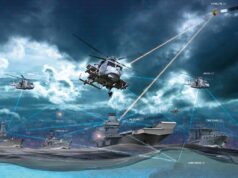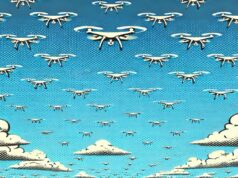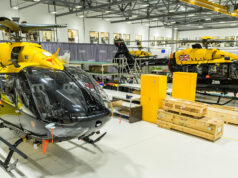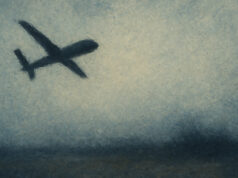As Kyiv’s counteroffensive to liberate Russian-occupied territories slowly advances in Ukraine’s east, the drone war continues to escalate.
Beyond the symbolic value of high-profile strikes against targets in Moscow, deep in the Russian heartland, and Novorossiysk, a key Russian port and export hub on the eastern shores of the Black Sea, this also has important operational and tactical implications for Ukraine.
It demonstrates the opportunities, and limitations, of technology on the battlefield and beyond.
Written by David Hastings Dunn, Professor of International Politics in the Department of Political Science and International Studies, University of Birmingham and Stefan Wolff, Professor of International Security, University of Birmingham.
This article is the opinion of the author and not necessarily that of the UK Defence Journal. If you would like to submit your own article on this topic or any other, please see our submission guidelines.
Ukraine routinely refuses to confirm its responsibility for drone attacks on Moscow, the most recent of which hit the Russian capital’s business district in July and August. But there can now be little doubt that this tactic is designed to demonstrate Ukraine’s capability to bring the war to ordinary Russians, even in their most protected city.
Beyond the attacks on Moscow, drones have been extensively used on the battlefields, both on land and at sea. They are now being deployed at such a rate that Ukraine is estimated to lose about 10,000 drones a month in combat. Videos widely circulating on social media apparently show how effective Ukrainian drones can be taking out Russian ships and tanks.
Morale boosters
Much like the well-documented drone attacks on Russian air force bases in December 2022, the recent strikes on Moscow – and the coverage they have received in mainstream and social media – are part of an important information war. This is designed to expose Russian military failures and vulnerabilities, while demonstrating Ukrainian ingenuity in adopting civilian technology and skills in a national defence effort. Much of this effort is crowd-funded by the civilian population in Urkaine and their supporters abroad.
Drone strikes, therefore, are also designed to boost morale back at home and among Ukraine’s western partners, at a time when the Ukrainian counteroffensive is making grindingly slow progress. Not only are they a sign that Ukraine can hit back at Russian territory, but they also demonstrate that its armed forces can do so with technology developed at home by a thriving military industrial sector.
Fast, small – and above all cheap – drones have proved an effective way for Ukraine to take out vastly more expensive Russian military technology. Given the restrictions attached to the use of western-supplied equipment against Russia, this is an important demonstration of a home-grown Ukrainian capability and determination to take the fight to the enemy.
Read more: Moscow drone attacks are a morale booster for Ukraine and a warning for Russia – here’s why
The attacks on Moscow also illustrate how much drone technology and its uses have evolved throughout the war. Initially, most Ukrainian drone use involved Turkey’s Bayraktar TB2, which achieved considerable success as a tank-buster in the early weeks and months of the war.
The role of this system and similar systems is now much reduced because more effective Russian air defences and electronic jamming have severely impeded Ukrainian drone use.
Recent reports have claimed that Ukraine might have found a way to evade Russian jamming, but details have not been forthcoming.
Rise of the kamikaze drone
As the use of drones evolves, the most significant development has been the use of so called “kamikaze drones”, which are deployed by both Russia and Ukraine. These drones have the advantage of being able to be directed in real time through first-person view devices – a tablet or a VR headset – and are both highly manoeuvrable and exceedingly fast.
They are also invulnerable to GPS jamming because they are hand-operated in real time using their cameras. And they are more difficult to intercept with anti-aircraft defences because of their speed, relatively small size and high manoeuvrability.
Read more: Ukraine war: Iranian ‘kamikaze’ drones can inflict serious damage but will not be a gamechanger
Commercially available, inexpensive and easy to operate, these systems are more accurate than artillery or mortar fire. They can also carry payloads from hand grenades to antitank warheads which can be used to lethal effect against all but the most hardened of targets. The footage they produce also has significant value in the information war.
Strike on Russian MANPADS position with the help of a kamikaze drone. By the Special Operations Forces of Ukraine. South direction. https://t.co/5SxdghdclB pic.twitter.com/cySnXAKrHv
— Special Kherson Cat 🐈🇺🇦 (@bayraktar_1love) June 15, 2023
The ability of these systems to be used in large numbers as coordinated swarm attacks is being worked on in anticipation of improving anti-drone defensive capabilities.
Drones have also played a vital role in the war in Ukraine because of their use for reconnaissance. They have made the battlefield much more transparent. This allows Ukrainian units to direct fire from artillery and mortars in a way that is more like targeted sniper fire than the barrage approach adopted by the Russian side with its more plentiful supplies of shells.
Key part of Ukraine’s armoury
Ukrainian capabilities are likely to increase further in this regard, following the announcement by German arms manufacturer Rheinmetall that it will supply its LUNA unmanned reconnaissance drone to Kyiv. This has a datalink range of up to 300 kilometres and can loiter near targets for up to 12 hours.
The excitement that drone technologies have created beyond the battlefield, however, should not be mistaken for a game-changing impact on the front lines. Drones, so far, have not been able to have much impact on the deeply-entrenched defences Russian forces have built up along the 1,200km-long front in Ukraine. Neither do drones have the same blast capabilities as traditional air power.
But they complement very well what Ukraine and its allies have brought to bear against the Russian invaders for the past 18 months. They can rightly be credited with offsetting some of the disadvantages that Ukraine has against its much larger, aggressive neighbour in the east.
Drones bolstered Ukraine’s military and psychological defences early on in the war and they are likely to damage Russia’s as Ukraine continues its liberation.













Drones have made armored attacks even more costly with their complete absence of appropriate air defences.
Back in ancient history (last century), someone flew a wood & cloth based biplane all the way to the Red Square in Moscow. The only thing that showed up on radar was the engine & it flew so slow, radar ignored it. Even modern fighter radars would ignore it on the assumption it was either a bird or fast moving ground vehicles (if you didn’t ignore it, too many ground vehicles would trigger downward looking radars to the point they were unusable).
If you are doing Mach 2, you are either military or well advertised civilian. If you can fly at the speed of a goose with a similar radar return, are you a goose or something else?
DJ wrote:
Classic example of Chinese whispers mate: The incident you refer to transpired on the 28th May 1987 when 18-year-old German national Mathias Rust flew a rented Cessna F172P from Helsinki to Moscow entering Russian airspace from Estonia. Whilst he did land next to Red Square, he was picked up by Russian radar and a couple of Mig 23s picked him up (and then lost him) where permission to engage was denied. Lets not forget that it was only 3 years after the Russians shot down Korean Air Lines Flight 007 (269 deaths) after it strayed into Russian Air space causing a huge embarrassment for Moscow, so I suspect that incident played heavily on the upper echelons and to add icing onto that cake the US and USSR were busy with Intermediate-Range Nuclear Forces Treaty (signed 4 months later, which saw Rust released as part of the day) But that said, it did expose the protracted Byzantine decision making process of the Soviet system and resulted in the biggest purge of Russian military personnel since Stalin, you’d think the Russians would have sorted that issue out, and yet here we are 36 years later seeing that same dragged out thought process at play.
wow the linked RUSI paper ( 10,000 drone losses a month) is worth a read. It’s interesting how intensive the use of drones has become on both sides, with suicide drones as well as drones essentially taking over reconnaissance roles ( 25-50 drones operating at anyone time over every 10KM of active front ). What is most chilling is the reconfiguration of the Russian infantry to Four different types of troops…disposable, line, assault and specialist with only assault and specialists being recognisable as actual trained soldiers in the NATO sense of the word…the use of the disposable troops is actually horrifying..these mixed units of conscripts and prisoners are drugged with speed etc an send forward in small fire teams to essentially get killed as a way to spot Ukrainian positions…with evidence they are shot if they try to retreat under fire and essentially due to drugs and fear keep moving forward till they are dead ( literal drugged up disposable suicide fire teams made of of conscripts that are send forward to be killed as a way to spot a position…that’s literally the definition of evil), they then send in further disposable troops or line troops to dig positions before either sending in assault troops ( to assault ) or specialist troops to attrition the Ukrainian positions ( snipers, artillery spotters etc)..its cynically horrifying and yet so very Stalin/Putin.
I agree, half way through it,(need a coffee break)
Yep it’s a read that needs a coffee break, what was also interesting was the implication that Russia had lost the ability to undertake combined arms operations due to loss of command and control infrastructure…with armour being used in penny packets of one vehicle as a form of Mobile artillery..only coming out in the mornings and evenings ( when they find it most easy to hide their IR signatures) as well as not closing to more that 1500meters to any enemy positions. Also the fact that their Effective fires now seems to be down to 120mm mortars and counter battery is loitering drones…effectively it looks like the Russian army can no longer undertake Mobile operations/combined arms ( hence the suicide fire team approach)…..it all looks like an untenable position that will break at some point. A nation could possibly justify it all as a last defence of its own soil, on friendly soil protecting a friendly population behind them…..but for offensive opps in another nation with an unfriendly population behind you and far from home, it’s all going to collapse around Putins ears hopefully ( you can only push a conscripted army so far before it rebels or just gives up…especially when they are not directly protecting their own people and nation).
It’s also got major implications for western expeditionary military’s as well, for all the US power the US army and all NATO forces were unable to control Iraq or Afghanistan despite also having local democratically elected governments in support.
Things like modern media, mobile communications and drones make it almost impossible for any army to impose its will on a local populace in the medium to longer term.
Very much why we should be shaping our army to be a high end war fighting force able to deploy a large force for a short period of time and getting away from the concept of long deployments.
We should either be deploying a division for a few months in a high end situation of a battalion sized group for long duration (local army training) type roles and basically nothing in the middle.
Just like to highlight that whilst the usual suspects on here (you know who you all are) will understand that 99% of the 10000 UAVs lost a month by the Ukraine are the small hobby drones you can purchase for a few hundred quid , the fly by night visitors will not, things aren’t helped by the top picture of what looks like a MALE UAV (Iranian Shahed 136 loitering munition range 2000kms 50 kg warhead) which I suspect the pro-Russian propagandists will cite when selling their pitch. The simple fact remains that small hobby drones operate over a very small RF spectrum powered by small battery powered units and are easily overpowered and spoofed by the military grade ECM units the Russians are using (I’ve read that the Russians place them 10 Kms apart) I suspect that things are a lot harder for the Military UAVs the Ukraine has received from the West to take out. There is a perfect example of one such override when a UAV spotting for a HIMARs strike turns away from its target (Too late to stop the HIMARS strike) and another UAV wasn’t affected whilst watching the strike.
This shows how important having access and control to low earth orbit satellite internet constellations like one web and starlink is, the drones being used for long range operations in the Black Sea appear to be using starlink for control. It viral that the UK continues its build out with one web as we don’t want to be in a position where some like Elon Musk is wielding major Geo political control un checked.
It’s going to soon be way more important having access and control of such a system than something like GPS.
Musk is denying he is denying Starlink to drone operations, don’t know how true tgzt is. I agree we should never have given up control of OneWeb. Just when you think the Govt makes a sensible decision it almost inevitably follows that they then shoot themselves in the foot. OneWeb is now an American Company effectively controlled by the French, what could possibly go wrong.
Satellites, Drones, cheap anti air & anti tank missiles, fast, lightweight dune buggies, Infantry en masse and trench rushing.
The shape of future warfare.